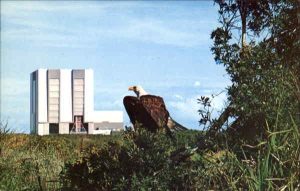
![]() From the launch of the Soviet satellite Sputnik in 1957 to the last Apollo mission to the moon in 1972, the Space Race was associated with tremendous advances in technology. At the same time, however, it was linked to a growing awareness of the Earth as an increasingly vulnerable environment.
From the launch of the Soviet satellite Sputnik in 1957 to the last Apollo mission to the moon in 1972, the Space Race was associated with tremendous advances in technology. At the same time, however, it was linked to a growing awareness of the Earth as an increasingly vulnerable environment.
The shock of the atomic bomb and the rise of Cold War fears of global annihilation led to serious consideration of colonies in space, not only by scientists and philosophers, but also media figures including Ray Bradbury and Marshall McLuhan. Revising the language of nineteenth-century exploration and expansion, newly elected John F. Kennedy described a “new frontier,” beyond which lay, in his words, “uncharted areas of science and space.”
While suspicious of technology in general, early environmentalists were not particularly hostile to the space program. Perhaps this is because, as funding dwindled for space research, NASA officials began to ally their efforts with the environmental wonders of Cape Canaveral. With the donation of a large tract of land to the Merritt Island National Wildlife Refuge, NASA shifted emphasis from its technological achievements to its role within the larger environmental movement. Publicity materials showed rockets framed by palm trees, and postcards of the Kennedy Space Center paired technological advances with alligators and eagles’ nests.
As fears of overpopulation and pollution began to replace earlier nuclear anxiety, the space program tapped into the desire for solutions that extended beyond the limits of the planet. Photographic images that looked back to the Earth from space underscored both the unity and the fragility of the planet as a whole, while the notion of space as the “final frontier” caught the popular imagination precisely at a time of social divides. Cosmologist Carl Sagan warned “the Earth is almost fully explored and culturally homogenized. There are few places to which the discontented cutting edge of mankind can emigrate….Space cities provide a kind of America in the skies….”[footnote]Robert Poole, Earthrise (New Haven and London: Yale University Press, 2008) p. 163.[/footnote]
But this nationalist view was countered by the “whole Earth” mentality that fueled the first Earth Day in 1970s. By the early 1970s, the notion of “Spaceship Earth” had become associated with the environmental movement. Rather than acting as an icon of the magnificent technological achievements of the space program, the “blue marble” photograph taken on the last Apollo mission became the most powerful symbol of our need to protect the Earth’s finite resources and complex ecological systems. Appearing on flags and buttons, posters and book covers, a view of the planet only actually seen by a handful of humans has evolved into a symbol that resonates even more powerfully in today’s age of global climate change.